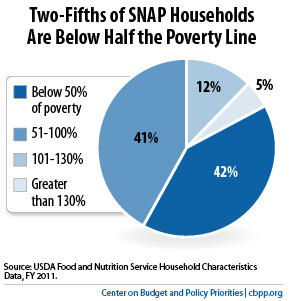BEYOND THE NUMBERS
New information from the House Budget Committee shows that Chairman Ryan’s planned cuts in SNAP (formerly food stamps) are even more draconian than we originally thought.
The report clarifies that the Ryan budget’s proposed conversion of SNAP to a block grant — which accounts for $125 billion of the budget’s $135 billion in SNAP cuts over the next decade — wouldn’t take effect until 2019. As a result, all $125 billion of those cuts would occur over just five years. The kinds of changes this would require are extraordinary.
To illustrate what this means:
- If the cuts came solely from restricting eligibility, 12 to 13 million people would need to be cut from the program.
- If the cuts came solely from across-the-board benefit cuts, benefits would have to be cut by more than $50 per person per month in 2019 (for a family of three, that’s $1,800 over the whole year). Put another way, the maximum SNAP benefit would be set at just 73 percent of the Thrifty Food Plan, the Agriculture Department’s estimate of the minimum amount a family needs to afford a bare-bones, nutritionally adequate diet.

The overwhelming majority of SNAP households are poor families with children, seniors, or people with disabilities. Almost three-quarters of SNAP participants are in families with children; more than one-quarter are in households that include senior citizens or people with disabilities.
As our recent post showed, SNAP helps millions of Americans afford enough food for their families — and provides a critical boost for many local economies. The Ryan budget’s proposed SNAP cuts are extreme and would hit both families and communities hard.
